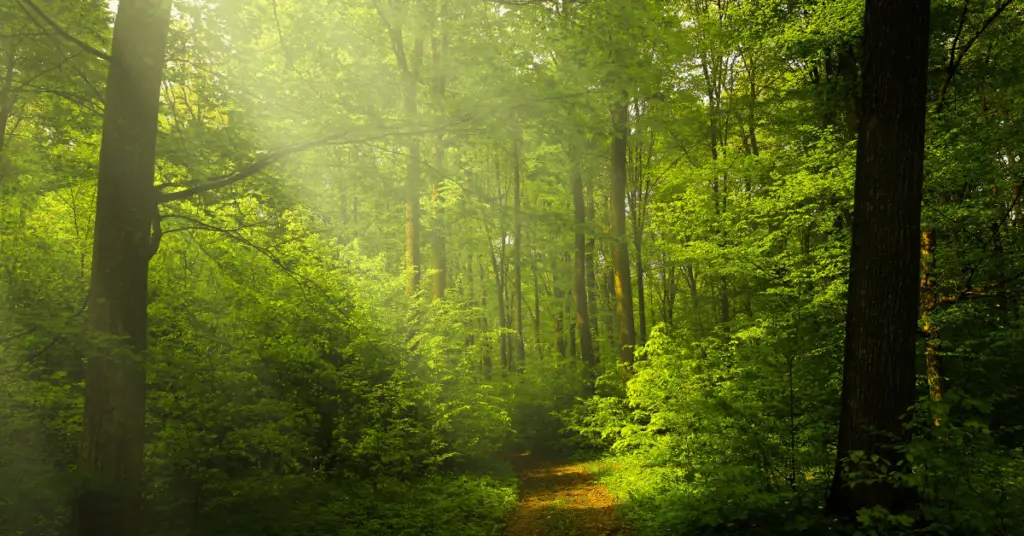Trees help the environment by providing shelter, shade, and food for other living things. They purify air and water. They incredibly beautify every corner of the world. They humbly fuel much of human society and the economy. They convert carbon dioxide into oxygen, making them heroes in their quest to stop global warming.
Many of the same human actions that cause global warming are also degrading the world’s forests. This is a double whammy because trees absorb carbon when they are alive, but emit it when they are dead, so trees that are felled not only stop capturing carbon—they also give it off.
Worldwide, deforestation is responsible for a fifth of carbon dioxide emissions into the atmosphere. The Union of Concerned Scientists reports that carbon capture by forests has decreased 20 percent between 1990 and 2001, primarily because of land clearing for development and destructive forestry practices.
However, they believe the potential for carbon sequestration in the United States forests, grasslands and farmlands could offset even more than 20 to 45% of the annual carbon dioxide emissions they currently capture if we reverse these practices.
Of course, conservation is the best sequestration, meaning that we absolutely need to reduce our emission of greenhouse gases. The current load clearly exceeds the catchment capacity even of our noble forests.
We can offset carbon dioxide significantly by planting trees, and by ensuring that the trees currently standing stay that way, green and aging, mature forests sequester carbon better than younger ones.
Planting a tree is simple and wonderful. It nourishes nature and also your soul.
Kenyan Nobel Peace Prize winner Wangari Matthai started the GreenBelt Movement in 1977, which organized poor rural women to plant trees in response to the scourge of deforestation. Since then, these extraordinary women have planted 30 million trees.
Los Angeles-area residents can take part in Mayor Antonio Villaraigosa’sMillion Tree Initiative, which began in 2006. Organized by TreePeople and the Los Angeles Department of Recreation, the tree-planting venture counts on volunteers to plant trees in the metropolitan community.
Tree planting can be a solitary, family, or group activity. Local garden centers, cooperative extension offices, and forestry services are also excellent sources of information and can even provide seedlings!
Planting trees help to fight global warming. It adds beauty to an area, aids in community-building, and can serve as a memorial for honoring someone special. A true green gift, trees provide protection from the sun and wind and are home to birds and other wildlife.
You’ll love planting trees alone, but there are also ways to support tree planting and carbon capture around the world without handling a shovel. Several organizations are running tree-planting campaigns.
Trees for the Future works with local communities to restore degraded lands by planting trees in Africa, Asia, and Latin America. Through American Forests’ Global ReLeaf initiative, you can support the planting of trees throughout the United States.
Through the Arbor Day Foundation, you can support tree planting and also get key tips on how to plant and maintain trees yourself. On www.climatecare.org, you can offset carbon emissions through funding an array of sequestration projects, including rainforest reforestation.
And you can even plant trees when you take a plane trip. Conservation Fund’s “Go Zero” carbon-offset initiative for travelers plants native trees to offset carbon resulting from travel.
Trees aim high—let’s learn from their example! You can stand tall in your carbon-positive quest by organizing and implementing a tree-planting project of your own.

Erzsebet Frey (Eli Frey) is an ecologist and online entrepreneur with a Master of Science in Ecology from the University of Belgrade. Originally from Serbia, she has lived in Sri Lanka since 2017. Eli has worked internationally in countries like Oman, Brazil, Germany, and Sri Lanka. In 2018, she expanded into SEO and blogging, completing courses from UC Davis and Edinburgh. Eli has founded multiple websites focused on biology, ecology, environmental science, sustainable and simple living, and outdoor activities. She enjoys creating nature and simple living videos on YouTube and participates in speleology, diving, and hiking.

